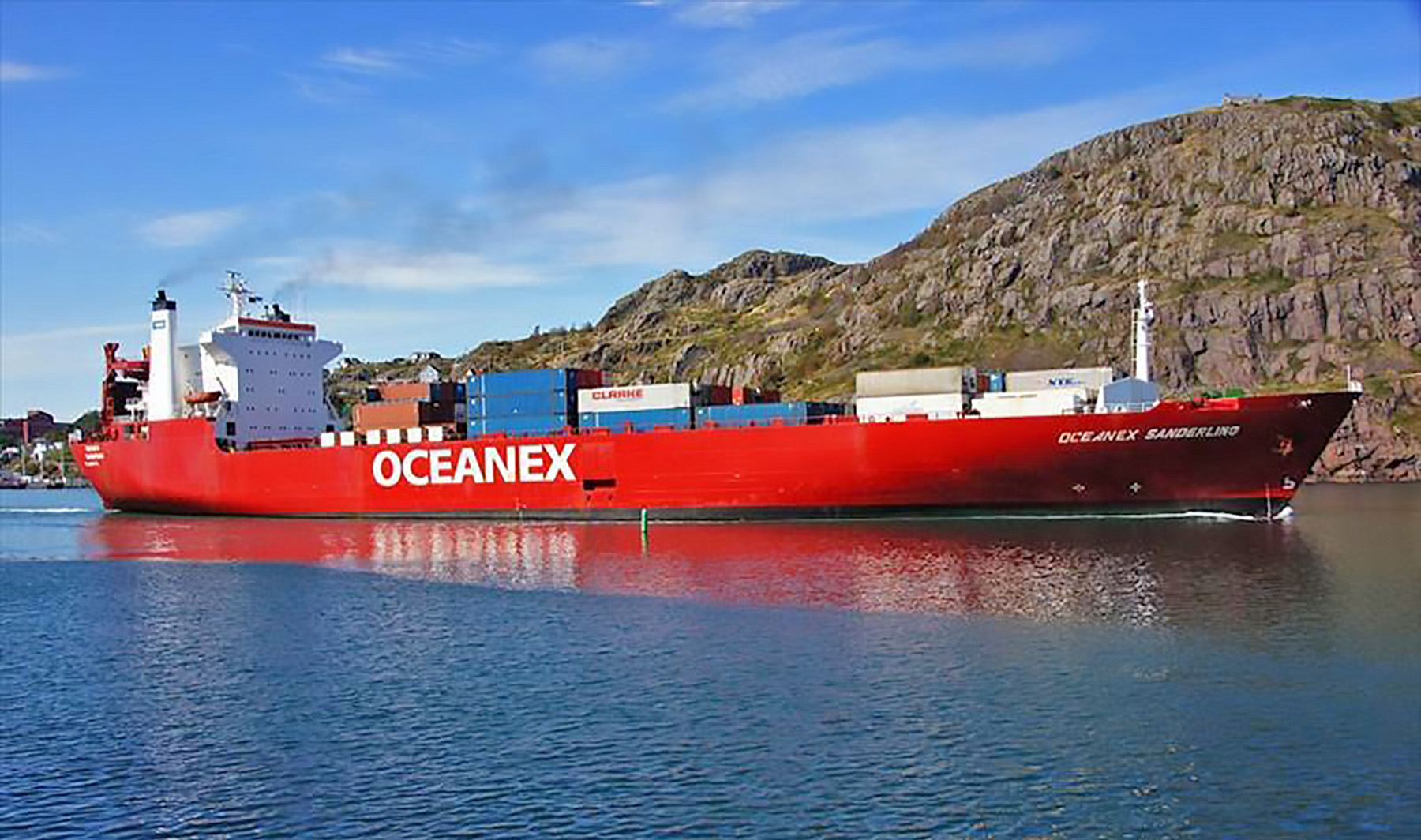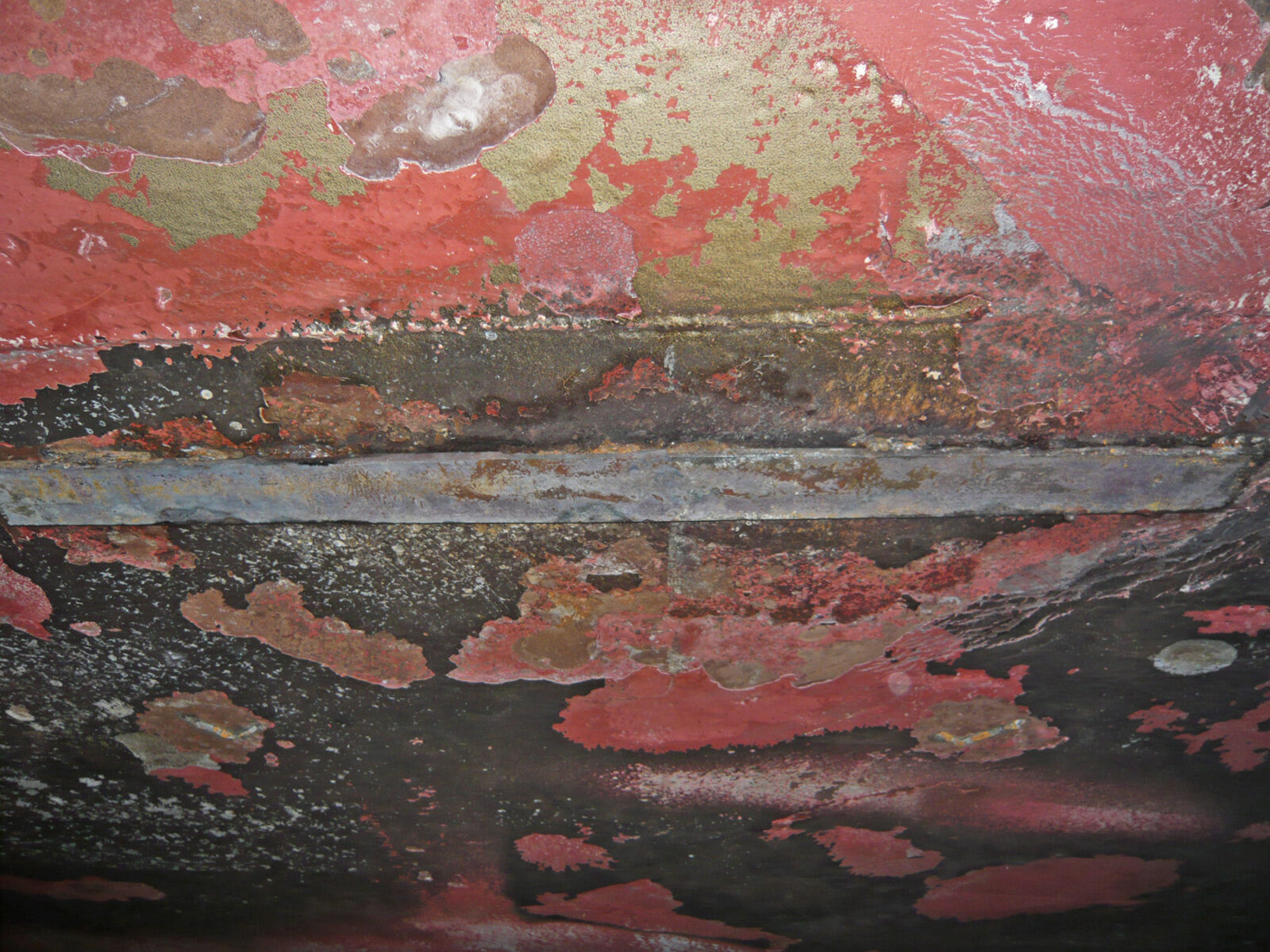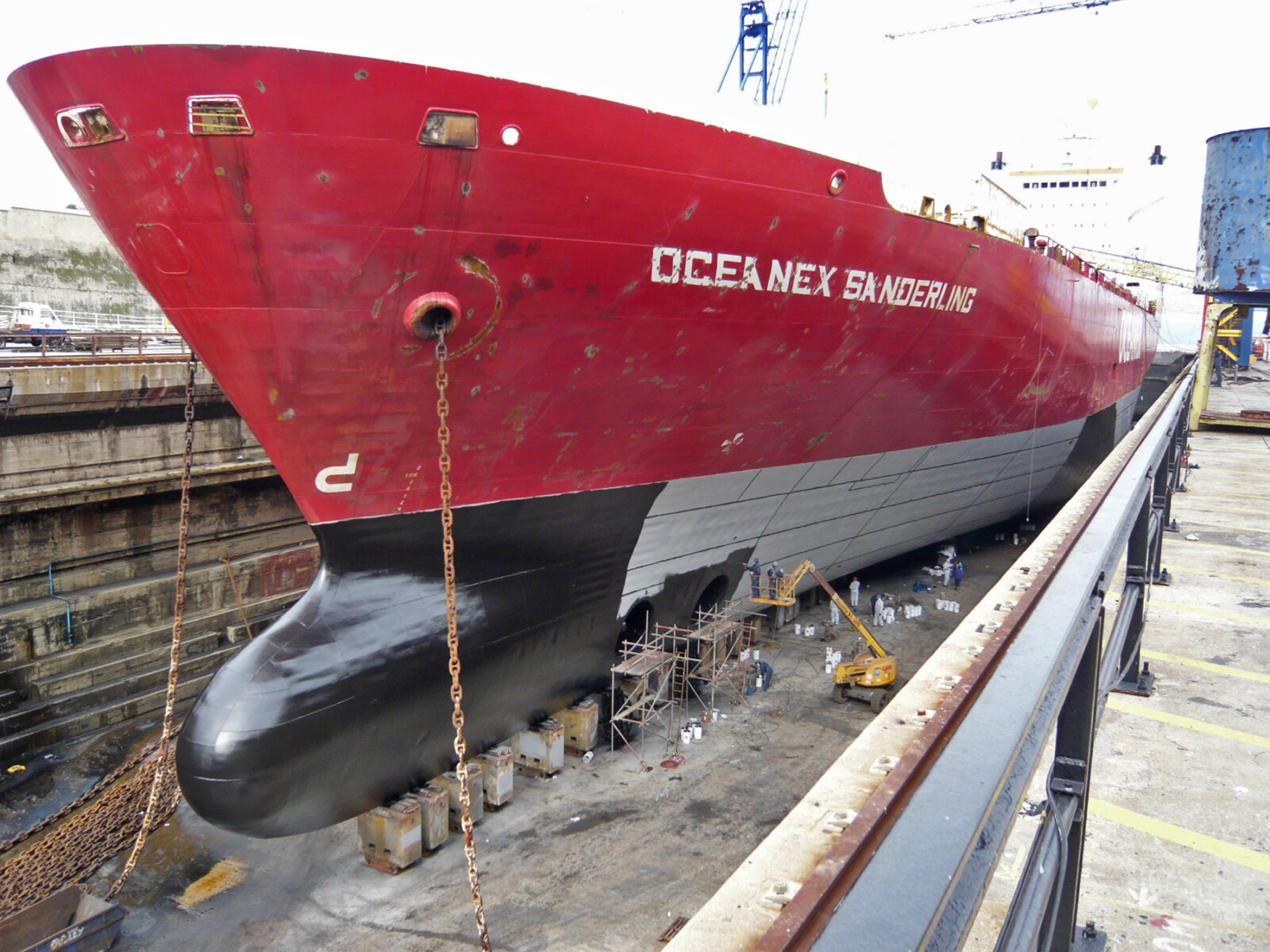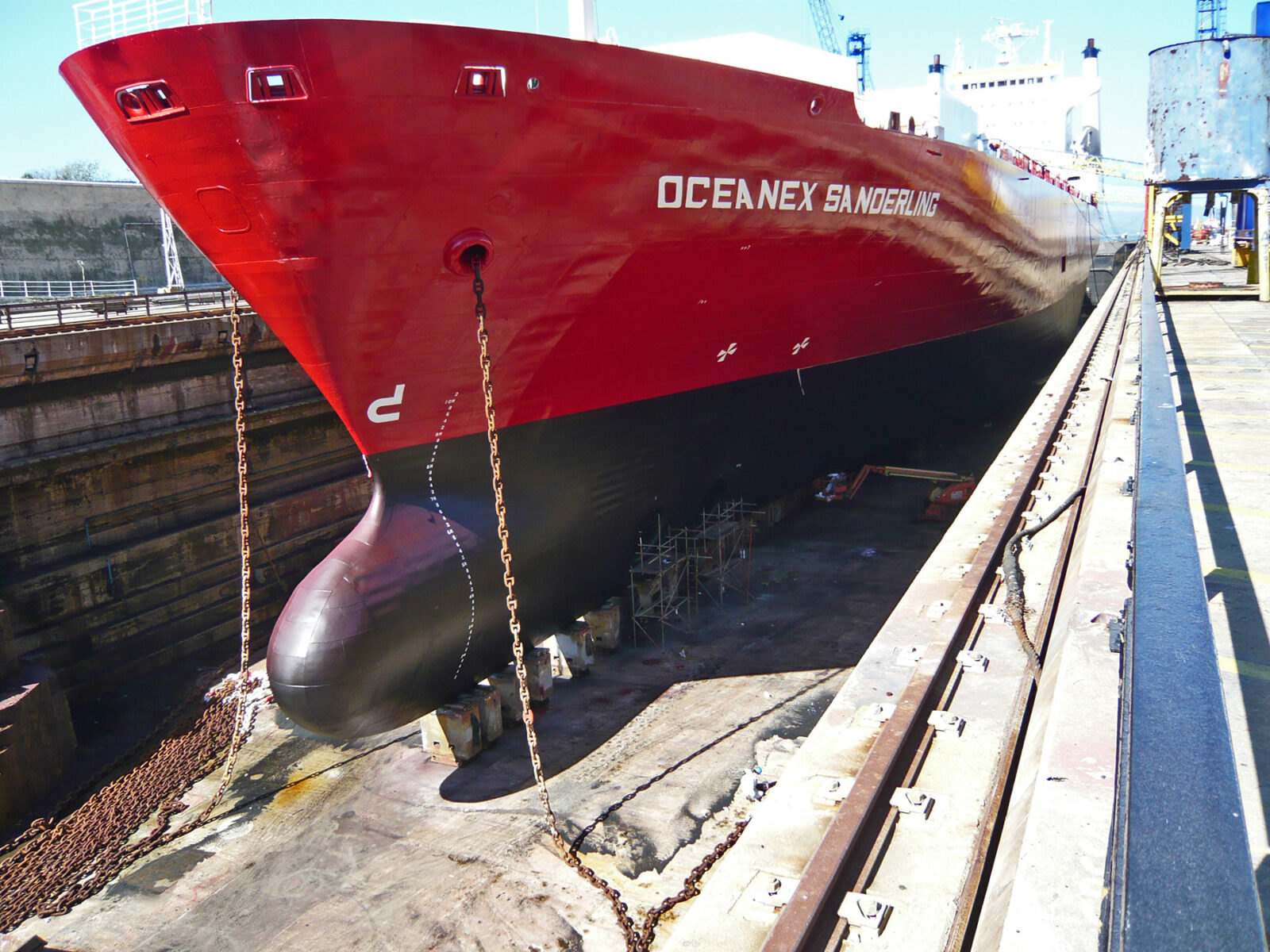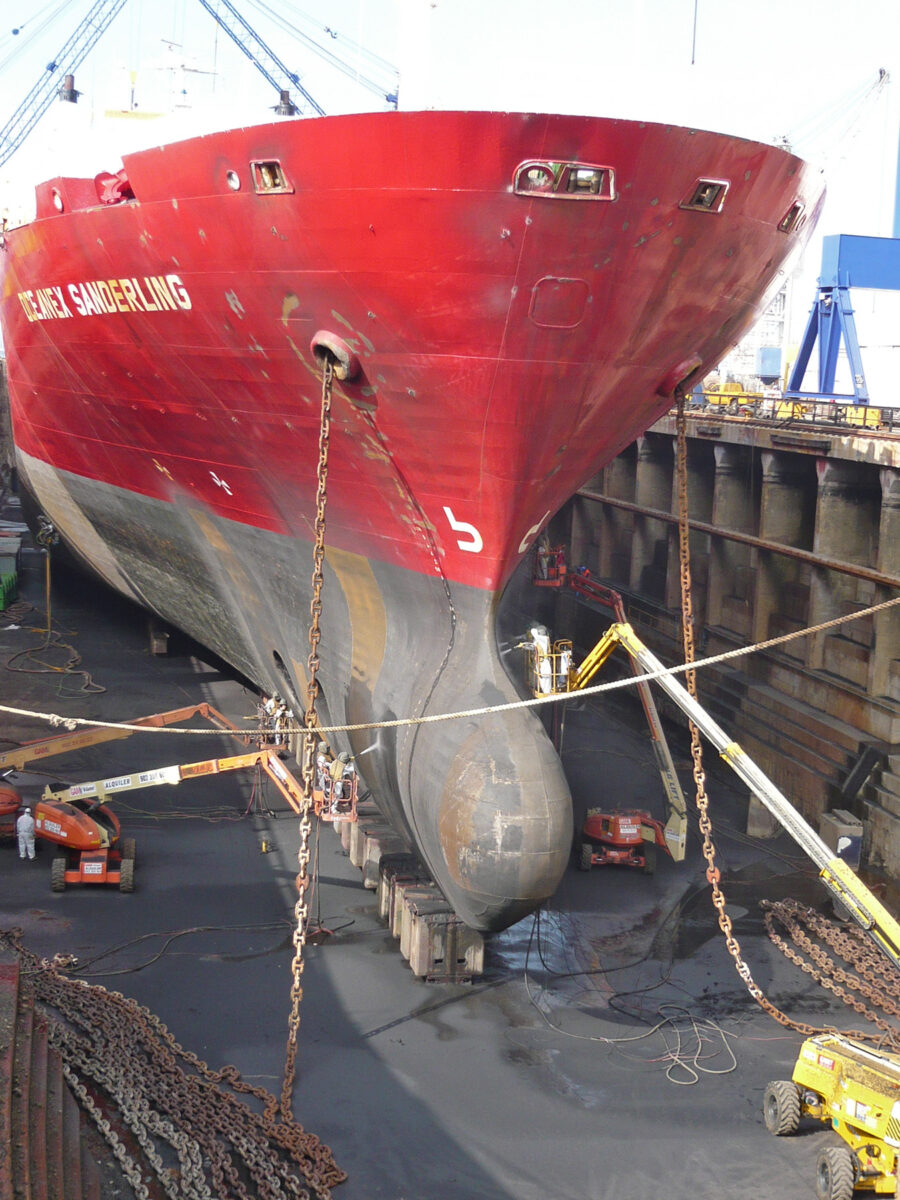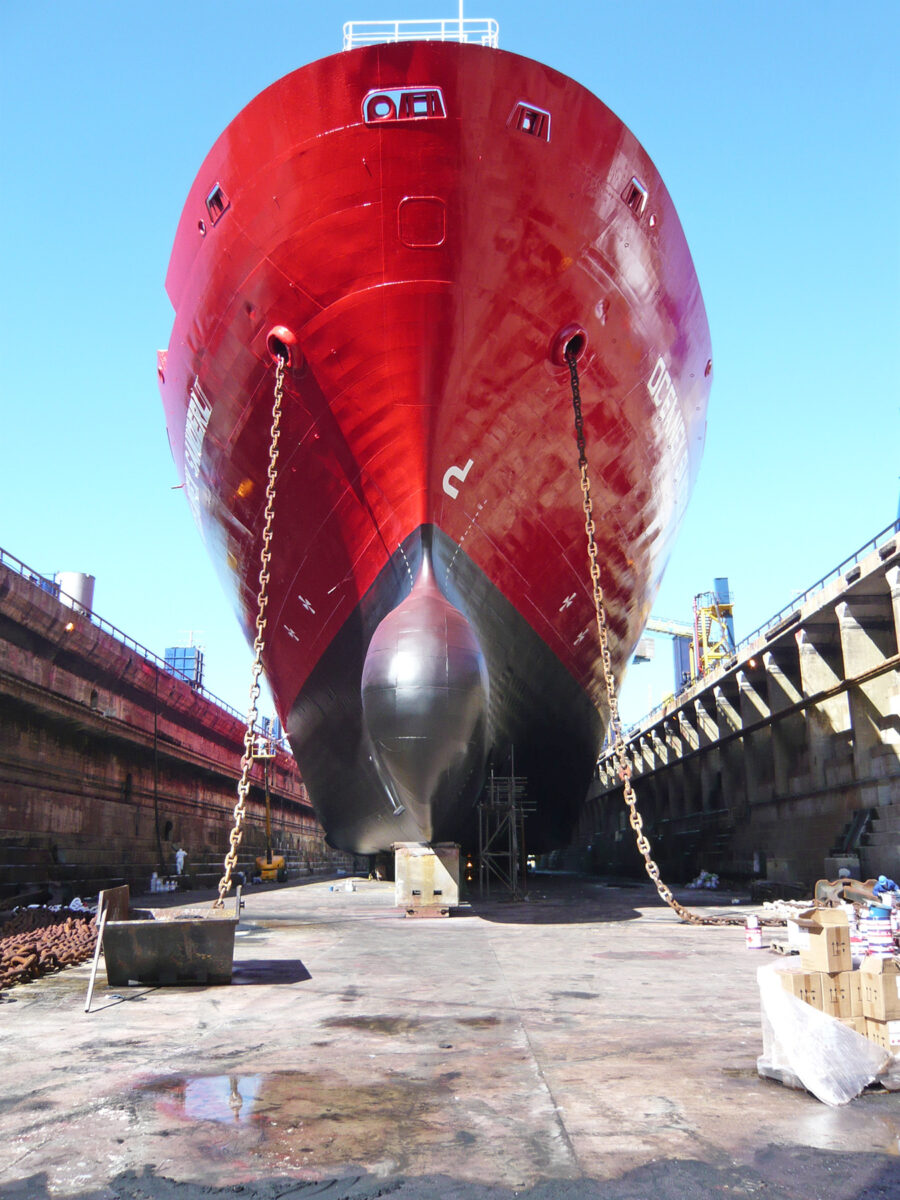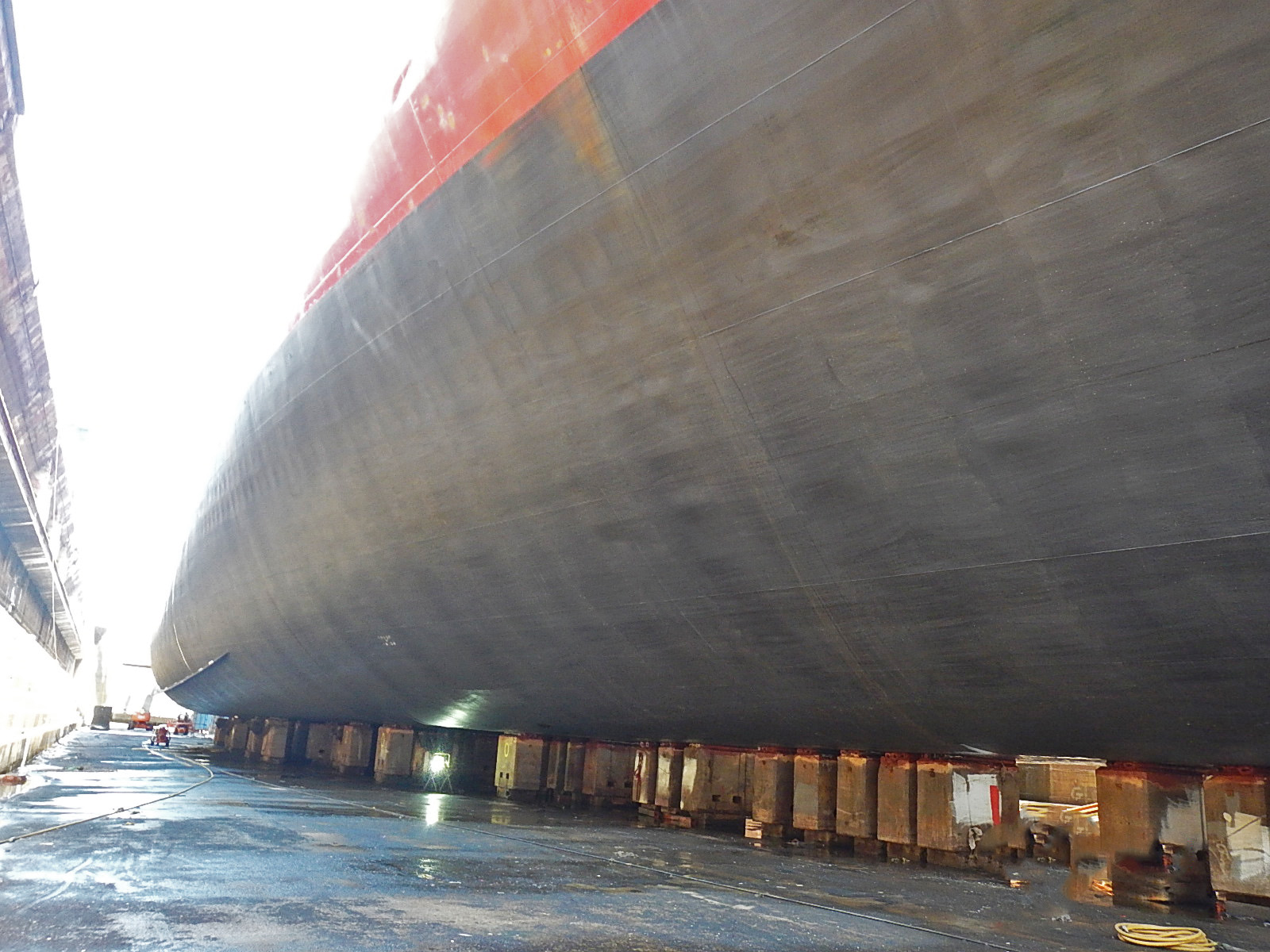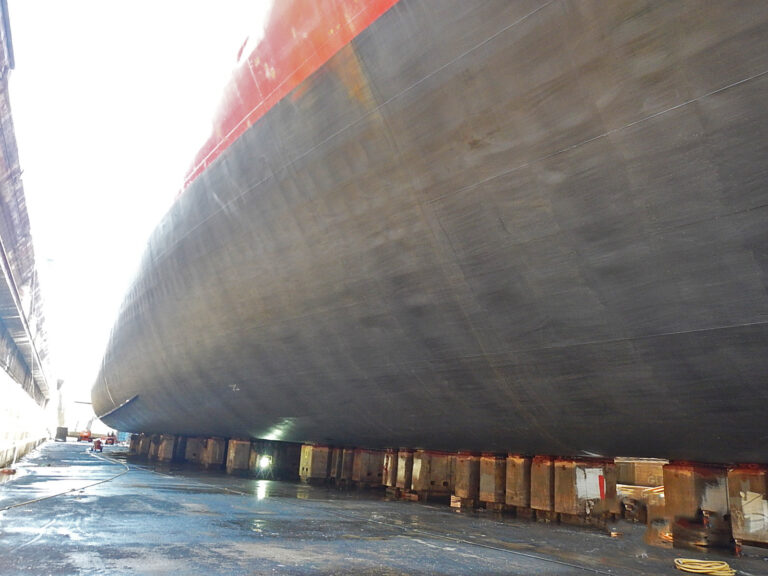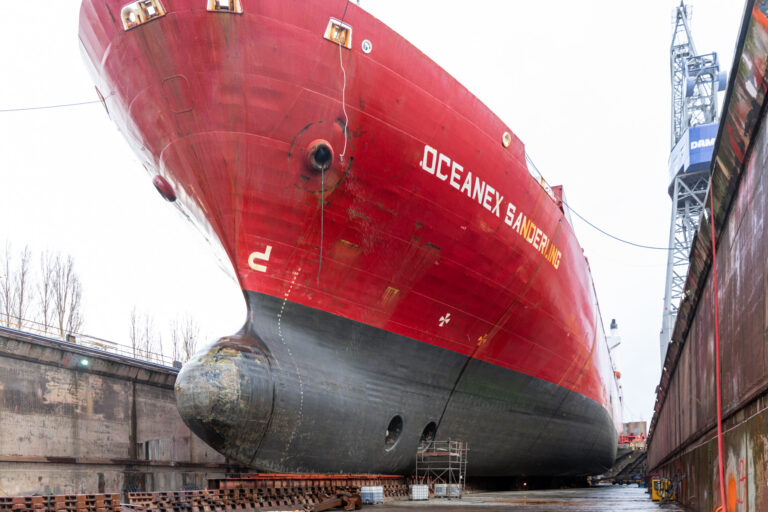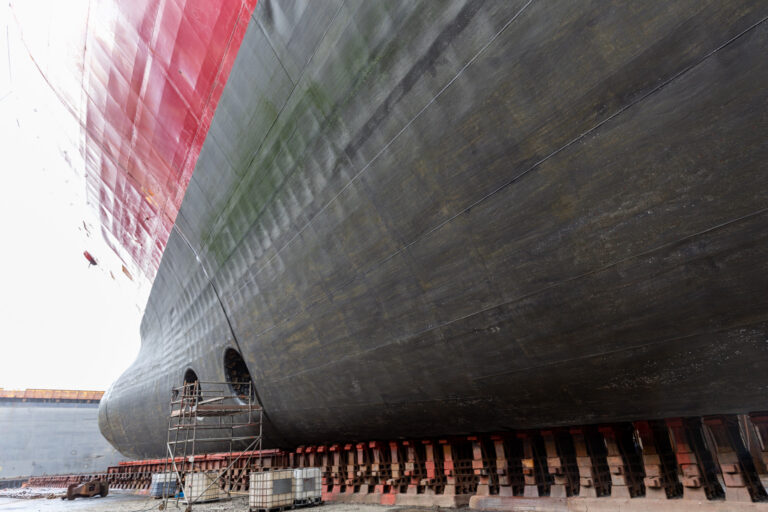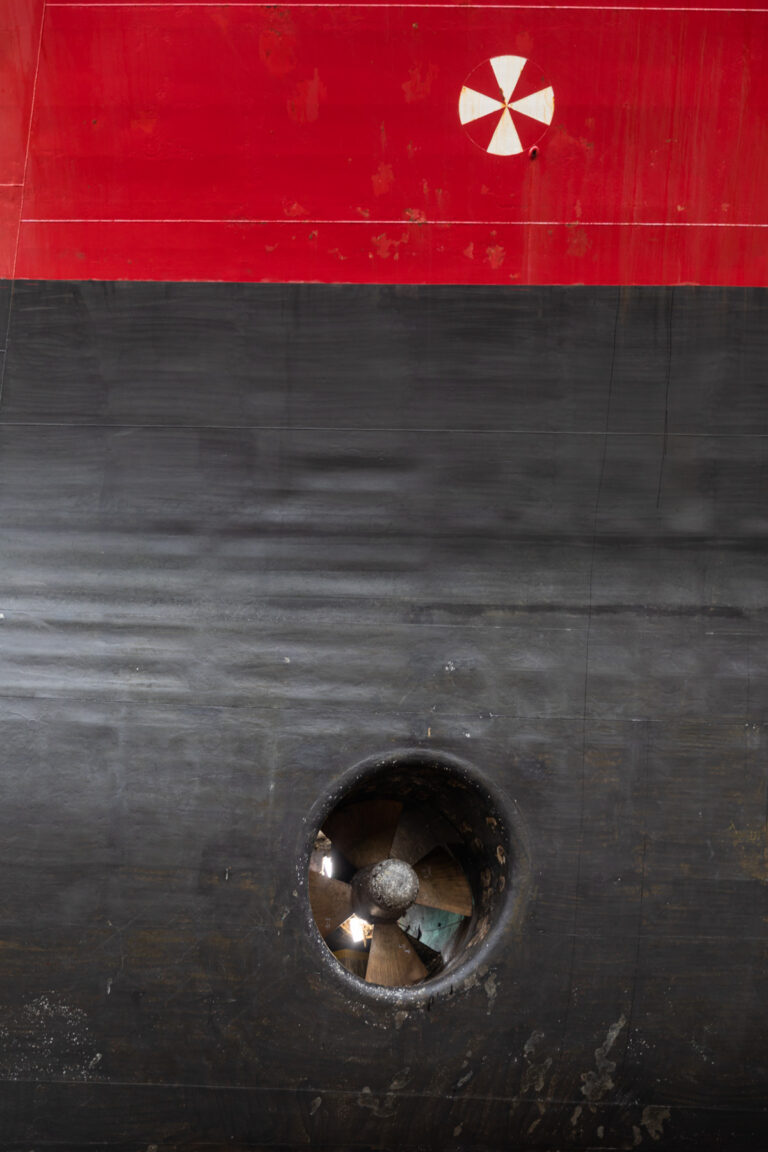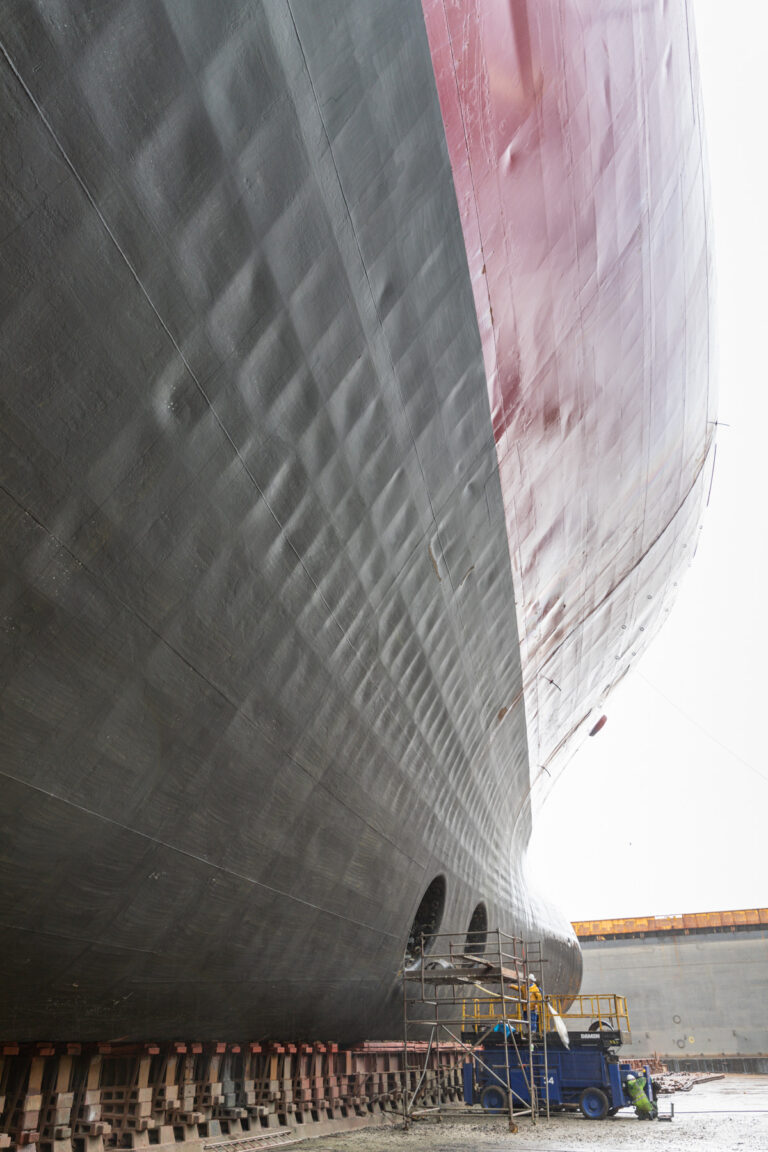Oceanex Sanderling hull coating condition still excellent after 11 years
Ships emerging into drydock from service in ice waters usually show major wear and tear beneath the waterline. Abrasion and collision with floating ice, which may also contain sand, grit, lava and gravel, rapidly strip away conventional coatings. Bare metal is left exposed to the corrosive effects of air and salt water.
Annual repair of the worst areas of coating damage is the normal expectation in these conditions, requiring days out of service and large costs. Blasting back to bare metal and a complete recoating job is unavoidable at five year drydockings, or even more frequently.
Not all ships have to incur these major expenses, however. When the Oceanex Sanderling came into Gibdock in April 2016 for a scheduled drydock, the most striking feature was the condition of her underwater hull. Rather than the rusted exposed steel and patchy paint which is usual for a ship that spends its life in harsh winter waters, the Sanderling’s hull looked as good as new.
Now again in January 2022, 11 years after the original application of Ecospeed, drydocking shows the hull coating is in excellent condition. There has been no need to replace the coating in 11 years and the Sanderling left drydock with only minor touch-ups to the hull coating.
Initial Ecospeed application in 2011
The Sanderling is a 1,125 TEU con/ro vessel, carrying containers, trailers and motor vehicles between Halifax and St. John’s through challenging ice waters off Nova Scotia.
In 2011, Oceanex decided to replace its regular antifouling system with Ecospeed, the glass-flake coating system provided by Subsea Industries.
Despite the conditions, the coating required virtually no repair after all the ice could throw at it. Instead of a full recoating with fillers, primer and top coat, the Sanderling’s paintwork beneath the waterline needed little more than a high-pressure wash.
In case the photo above gives an impression of light duty in pleasant seas, the video below should dispel any doubts as to the Sanderling’s working conditions.
“In 5 years of sailing in tough conditions between Halifax and St Johns we have not had to make any repairs to the coating and only very small maintenance. After high-pressure washing the coating is as good as new.
Gibraltar docking 2016
Bad weather and expensive drydock costs in Canada made drydocking in the Mediterranean area the most feasible option for the Sanderling.
Oceanex Fleet Technical Manager Iliia Daskalov says: “I’ve been at the ship’s 3 years drydock in Halifax when the paint was 3 years old and was found in very good condition. Now at 5 years old the paint is the same.
“In 5 years of sailing in tough conditions between Halifax and St Johns we have not had to make any repairs to the coating and only very small maintenance. After high-pressure washing the coating is as good as new.
“From the condition of the hull after 5 years, with no damage to the coating, I am now expecting that it will easily last for another 5 years and that it will look exactly the same when we next do a full drydock.”
He was right, as you will see below.
“From the condition of the hull after 5 years, with no damage to the coating, I am now expecting that it will easily last for another 5 years and that it will look exactly the same when we next do a full drydock.”
Tight deadline
The small amount of coating repair needed also allowed the whole drydocking procedure, including structural modifications, to be completed inside a narrow deadline.
Richard Beards, Managing Director of Gibdock, said: “The owner was quite clear that Oceanex Sanderling was required back in service within a tight timeframe, with minimal disruption to Oceanex customers.”
The condition of the hull meant that coating repair did not delay other work. Gibdock carriedout a large package of work on the Sanderling, which was then nearly 40 years old. Work required the removal of the con/ro ship’s stern ramp, which is made up of three sections. The largest section weighs 93 tons and involved the heaviest lift ever carried out at the yard.
Gibdock also removed Sanderling’s tailshaft for survey, removed and refurbished the rudder blade, reinforced the weather deck and fitted new container sockets to allow loading of 53ft containers.
Drydock in January 2022
Ecospeed is guaranteed for 10 years and has a life expectancy of 25 years, so the coating will continue to protect the Sanderling well past its 60th year. The entire system is applied in only two homogeneous coats.
A minimum of about 3 hours is required in between coats and there is no maximum overcoat time, allowing the coating job to be adapted to a shipyard’s schedule or to unpredictable weather conditions.
Maintenance of the underwater hull is very easy, whether by underwater cleaning or in a scheduled drydock: Ecospeed’s extremely tough surface can be cleaned of even the heaviest fouling by high-pressure wash. In-water maintenance procedures can be repeated whenever needed during the vessel’s lifespan without damage or deterioration to the quality of the coating’s surface. In fact, each cleaning further improves the coating’s surface characteristics.
The Oceanex Sanderling was again out of the water in January 2022 for a routine drydocking. This was 11 full years after the initial application and no recoating or any major repair of the hull coating had been done.
The condition of the hull was virtually the same as it had been 6 years before in Gibraltar.
11 years after the original application of Ecospeed, with no repaint over that period, the hull coating was still in excellent condition.
Ecospeed, protection and performance
Besides extreme resistance to ice damage, the coating is also uniquely effective in protecting against the effects of cavitation.
More speed, less fuel
Experience with other ships has shown that the Ecospeed system helps the ship’s underwater hull to operate at optimum performance throughout its service life, bringing a significant reduction of fuel consumption.
Mr. Daskalov continues: “We clean with divers each year before the spring and we are also very pleased with the speed and fuel efficiency which the coating is giving us.”
This reduced fuel consumption brings down bills, whilst leading to a corresponding reduction of the carbon footprint, offering additional value in terms of corporate responsibility towards cleaner seas and environmentally safe ship husbandry. The fact that Ecospeed is 100% non-toxic throughout the entire service life of the vessel greatly adds to the environmental benefit.
Cumulative saving
There is also a cumulative saving to be achieved from a coating that does not wear away, as hull roughness from paint repairs builds up rapidly as patches are recoated piecemeal.
Studies by Dr. R.L. Townsin have attributed 40μ per year of added roughness to degradation of regular antifouling paints, while the Arab Academy for Science and Technology and Maritime Transport estimate that each 10μ of added roughness reduces speed by 0.03 knots and in- creases fuel consumption by 1%.
Based on these figures, after five years service a ship might be suffering a 16% fuel penalty due simply to the rough condition of its paint. Eco- speed does not suffer this degradation and re- mains immune to this problem throughout its lifetime.
Strength needed
The most important consideration for ships sailing in ice is protection. This requires a real- ly tough coating that can resist the abrasion of the ice, and continue to adhere under constant pounding and scraping.
It also requires a degree of flexibility, as coatings that are brittle or inflexible are subject to crack- ing or disbonding when panels flex, bend, or even permanently dent under impact from the ice.
As soon as the hull coating is damaged, corro- sion of the underlying steel can set in and spread. This does not occur with Ecospeed.
“We clean with divers each year before the spring and we are also very pleased with the speed and fuel efficiency which the coating is giving us.”
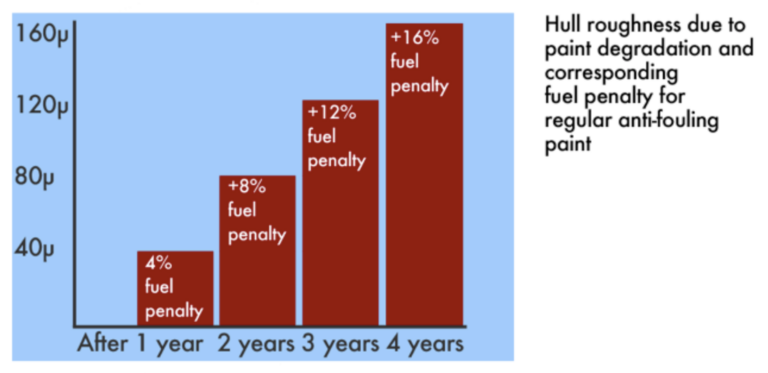

Ice precautions, less steel required with Ecospeed
The risk of ice affects large areas of trade. On average, sea ice covers about 25 million square kilometers of the earth’s surface (about two-and- a-half times the area of Canada). In the Northern Hemisphere, it can exist as far south as 38o N (700 kilometers closer to the Equator than to the North Pole). About 15 percent of the world’s oceans are covered by sea ice during part of the year.
This ice can be hard to spot, even with state-of-the art radar. Experienced captains will watch out for phenomena such as fog, abrupt moderation of the sea swell, and ice blink, a luminous reflection on the underside of the clouds above the ice or a light or yellowish haze.
One result is that ships sailing in ice require more steel. “It is well-known that normal ship paints will wear off very quickly due to the wearing influence of ice-blocks on the hull”, notes a 1975 Paper for the Society of Naval Architects and Marine Engineers in New York. “Because of corrosion this has finally led to overdimensioning of the hull plates with an increase in the lightweight of the ship as a result.”
After examining the resistance of Ecospeed to ice abrasion, Class Societies have concluded that steel plating thickness for vessels trading in ice can be reduced if the hull is to be coated with Ecospeed. The corresponding weight advantage is not just cheaper in terms of the steel required, but also results in yet another reduction of fuel consumption or an equivalent increase in cargo that can be taken.
Increasing fleets, decreasing environmental impact
Large oil and gas reserves in northern territories of the U.S. and Canada are now prompting additions to ice-going fleets, and the prospect of receding solid ice is tempting operators towards routes in higher latitudes where floating ice will remain a danger.
Owners with experience of Ecospeed in similarly testing waters include VG Shipping, Fednav, the British Antarctic Survey, Group Ocean, the Royal Navy, Staten Island Ferry, Interscan, Gearbulk and W&R Shipping. Owners have expressed a high level of satisfaction with the product in terms of both longevity and efficiency.

